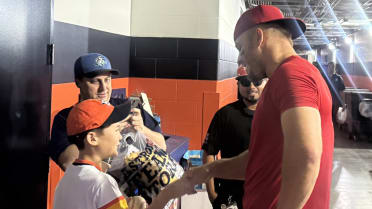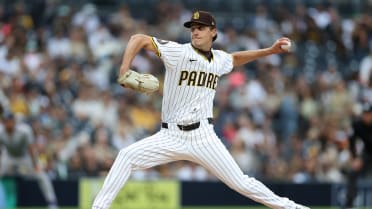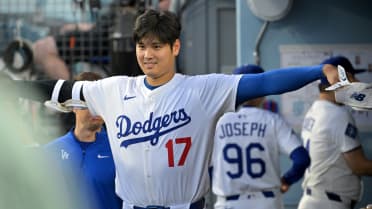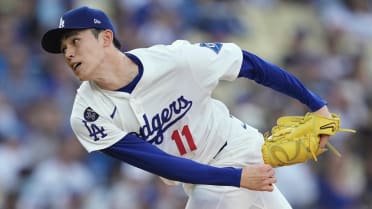A version of this story first appeared on MLB.com on Jan.8.
As Hot Stove season got underway, MLB.com looked at past position players who had been similarly valuable as Bryce Harper and Manny Machado -- the offseason's two elite, 26-year-old free agents -- through age 25, and at how they fared from 26-35. The 43-player sample was largely a successful one, with all but five producing at least another 20 wins above replacement (WAR) during that 10-year period, and many going on to the Hall of Fame.
While this sort of historical context is useful, we also can provide another perspective by checking out some actual projections for Harper and Machado. To that end, sabermetrician Brian Cartwright provided MLB.com with seven-year projections for both players, via his Oliver system, which factors in a player's recent performance and age.
Below is a year-by-year examination of the results for Harper, who agreed to a record-breaking pact with the Phillies. While that deal is for 13 years, it's difficult enough to project a player seven years into the future, and this exercise will provide a glimpse at how Harper might do, at least through what should be his prime.
It's worth keeping in mind that, like all projection systems, Oliver is inherently cautious and unlikely to spit out extreme results on either end of the spectrum. To provide a wider view of the potential outcomes, MLB.com's Tom Tango used the Oliver projections to also create optimistic (90th percentile) and pessimistic (10th percentile) stat lines for each season.
That gives us three projections for Harper for every year from 2019-25, showing his slash line, weighted on-base average (wOBA) -- a version of OBP that gives credit for extra bases -- and WAR. That last figure is based on the assumption that Harper is an average right fielder, but continued defensive struggles or a move to first base or designated hitter would bring down those numbers. Each projection also comes with a 2018 comp, based on wOBA and WAR.
2019 season (age 26)
Optimistic projection: .288/.429/.557 (.427 wOBA), 42 HR, 7.1 WAR
2018 comp: Christian Yelich
Standard projection: .262/.390/.507 (.389 wOBA), 32 HR, 5.1 WAR
2018 comp: Aaron Judge
Pessimistic projection: .236/.351/.456 (.350 wOBA), 23 HR, 3.1 WAR
2018 comp: Justin Upton
Everyone is still waiting for Harper to recreate his MVP-winning 2015 campaign, when he posted a ridiculous .461 wOBA and 9.3 WAR. But even if that doesn't happen, there's no reason to expect the former No. 1 overall pick -- still firmly in his prime -- won't be one of the top hitters in MLB in '19. Harper is coming off a season in which his .376 wOBA tied for 14th among qualifiers, despite a long midseason slump.
2020 season (age 27)
Optimistic projection: .283/.425/.547 (.422 wOBA), 39 HR, 6.5 WAR
2018 comp: J.D. Martinez
Standard projection: .257/.387/.497 (.384 wOBA), 30 HR, 4.6 WAR
2018 comp: Brandon Nimmo
Pessimistic projection: .232/.348/.447 (.346 wOBA), 21 HR, 2.7 WAR
2018 comp: Nick Markakis
It's important to remember how young Harper is, despite how long he's been around. At 26, he's the same age Martinez was when he broke out with the Tigers in 2014, and just a year older than Nimmo was in '18, when he established himself in his first full big league season. While Nimmo isn't a big name yet, keep in mind that he just finished fourth in the Majors in OBP and ninth in wOBA, ranking right behind Paul Goldschmidt.
2021 season (age 28)
Optimistic projection: .277/.421/.532 (.416 wOBA), 36 HR, 5.9 WAR
2018 comp: Max Muncy
Standard projection: .252/.383/.483 (.378 wOBA), 28 HR, 4.1 WAR
2018 comp: Eugenio Suarez
Pessimistic projection: .226/.345/.435 (.340 wOBA), 19 HR, 2.3 WAR
2018 comp: A.J. Pollock
Pollock was one of the top free agents this offseason, after posting a .338 wOBA and 2.5 WAR in 2018 (albeit in an injury-shortened 113 games). That sort of performance serving as a 10th-percentile outcome for Harper is indicative of how strong his track record is, with his career-low .338 wOBA coming back in '14 (MLB-average wOBA this past season was .315).
2022 season (age 29)
Optimistic projection: .269/.415/.512 (.407 wOBA), 32 HR, 5.2 WAR
2018 comp: Muncy
Standard projection: .245/.377/.465 (.370 wOBA), 25 HR, 3.5 WAR
2018 comp: Joey Votto
Pessimistic projection: .220/.340/.419 (.333 wOBA), 17 HR, 1.9 WAR
2018 comp: Carlos Santana
Votto is an interesting comp, given that prior to the 2012 season he inked a massive 10-year extension with the Reds -- on top of the two years he had left on his previous deal. The All-Star first baseman already was 28 at the time, but he has continued to be one of the game's top hitters. Votto's power did decline significantly this past year (12 home runs), although few were better at getting on base. Only Mike Trout and Harper had higher walk rates, and that ability should serve Harper well as he ages.
2023 season (age 30)
Optimistic projection: .262/.408/.492 (.397 wOBA), 29 HR, 4.5 WAR
2018 comp: Justin Turner
Standard projection: .238/.370/.447 (.361 wOBA), 22 HR, 3.0 WAR
2018 comp: Nicholas Castellanos
Pessimistic projection: .214/.333/.403 (.325 wOBA), 16 HR, 1.4 WAR
2018 comp: Yuli Gurriel
As Harper reaches 30 -- a point when many players are just getting to free agency for the first time -- the chances are good that he still will be an excellent hitter. That was true last year of the 33-year-old Turner, who slashed .312/.406/.518 (.396 wOBA) after starting out on the disabled list. Like Harper himself, Castellanos showed such a potent bat that he managed to be a valuable player despite some ugly defense in the outfield.
2024 season (age 31)
Optimistic projection: .254/.400/.473 (.388 wOBA), 26 HR, 3.9 WAR
2018 comp: Ronald Acuna Jr.
Standard projection: .231/.364/.430 (.352 wOBA), 20 HR, 2.5 WAR
2018 comp: Andrew McCutchen
Pessimistic projection: .208/.327/.387 (.317 wOBA), 14 HR, 1.1 WAR
2018 comp: Joe Mauer
Like Harper, McCutchen was an immediate star upon reaching the Majors. Like Harper, he went on to win an NL MVP Award and become one of the game's biggest stars. McCutchen's more recent history is an example that even when a top player declines, he still has something to offer. Though no longer an MVP candidate, the 31-year-old McCutchen rode a strong walk rate and solid power to a .347 wOBA this past season, before inking a three-year, $50 million deal with the Phillies.
2025 season (age 32)
Optimistic projection: .246/.393/.453 (.378 wOBA), 24 HR, 3.3 WAR
2018 comp: Harper
Standard projection: .224/.357/.412 (.343 wOBA), 18 HR, 2.0 WAR
2018 comp: C.J. Cron
Pessimistic projection: .201/.321/.370 (.309 wOBA), 13 HR, 0.7 WAR
2018 comp: Rafael Devers
That's right, a 90th-percentile outcome for a 32-year-old Harper would be … the 25-year-old Harper we just saw. That version batted .249/.393/.496 for a .376 wOBA and produced 3.5 WAR even though he struggled defensively in right. If Harper still is able to swing such a dangerous bat seven years down the line, that would be a great result for the Phillies.
Seven-year results
Optimistic projection: 36.3 WAR
2012-18 comp: McCutchen
Standard projection: 24.7 WAR
2012-18 comp: Upton
Pessimistic projection: 13.1 WAR
2012-18 comp: Hunter Pence
Harper has produced 30.7 WAR over his first seven Major League seasons, according to FanGraphs, so a moderate projection would have him slightly underperforming that pace moving forward.
For further context, only three position players have totaled at least 36 WAR since 2012: Trout, Josh Donaldson and McCutchen. While it would be a lot to ask for Harper to meet the equivalent of his 90th-percentile projection every year, there also have been just 28 players with at least 23 WAR during that time.
Harper should continue to produce for years to come in Philadelphia.
Andrew Simon is a research analyst for MLB.com. Follow him on Twitter @AndrewSimonMLB.



